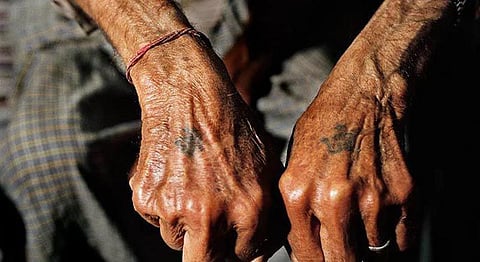
- HOMEGROWN WORLD
- #HGCREATORS
- #HGEXPLORE
- #HGVOICES
- #HGSHOP
- CAREERS
- ABOUT US
- CONTACT US

Considered to be one of the largest mass migrations in human history, the partition of 1947 hides so many untold stories. As the survivors kept their silence for years, their personal experiences remained hidden and weighed on their lives as unhealed baggage. The true horrors of that period will never truly be understood by a generation that did not live through the trauma. Yet we are left with archives, testimonies, and photographs that bring up an undiscovered side of the period every now and then.
Recently I came across a BBC documentary delving into the history behind the fading tattoos of partition survivors. Elderly citizens who were children in 1947 shared stories behind the many reasons their parents marked them with a tattoo. It made me wonder, in a country like India where tattoos have deep relevance for tribal communities and yet remain largely stigmatised, what part did body art play in the most difficult period of our collective past?
Image Courtesy: The Indian Express
Partition was a time when each individual’s personal identity was exaggerated, as it was either your biggest asset for safety or a threat to your family’s well-being. With controversial politics, it was always better to err on the side of caution. The rise in communal hatred had started before the day of migration, as the people in power utilised their position to worsen the animosity that lay dormant; leaving the common man to pay the price of their malice and further suffer in unimaginable ways.
The only way to escape the violence, at least from your own community, was through making your religious identity prominent. As proof of their faith, Hindus were marked with the ‘Om’ symbol, Muslims used a crescent moon, and Sikhs embodied the symbol of ‘Ek Onkar’. When individuals were prone to quick anger and violence these tattoos helped in keeping one’s families safe by pointing to the tattoo at the time of an attack.
During this period, it was also increasingly difficult to claim your family members as abductions were rampant. As noted by Brown History, to safeguard children from harm every family had a single decided symbol, such as a flower or a bird that was placed on each hand. This facilitated families in recognising members and asserting a relationship with their children when wrongly claimed by abductors. Similarly, some Hindu children also had a tattoo of three dots on their forehead or chin, instantly recognised as a sign of their faith.
L: Wikipedia ; R: Brown History
As in most of the other oppressive chapters of human history, partition impacted women much more adversely as they were tortured kidnapped and raped. Women were also forcefully converted and married to unknown men against their will. As their bodies were purely seen as possessions to be owned or molested by other communities, families marked their daughters with tattoos of political slogans. The nationalistic sayings included Pakistan Zindabad (Pakistan Forever) or Jai Hind (Long Live India).
These markers, presently fading away on the bodies of partition survivors, have always acted as a reminder of their dark and traumatic past. Living in such uncertainty required them to take extreme measures and yet they lost a huge part of their identity in the process of this tumultuous migration. We may never fully grasp the intensity of their painful memories, but as inheritors of the partition, the responsibility to make their stories heard is in our hands.
